The burden of diabetes and hyperglycemia in Brazil-past and present: findings from the Global Burden of Disease Study 2015
- PMID: 28293304
- PMCID: PMC5348777
- DOI: 10.1186/s13098-017-0216-2
The burden of diabetes and hyperglycemia in Brazil-past and present: findings from the Global Burden of Disease Study 2015
Abstract
Background: Diabetes, hyperglycemia, and their complications are a growing problem in Brazil. However, no comprehensive picture of this disease burden has yet been presented to date.
Methods: We used Global Burden of Disease 2015 data to characterize diabetes prevalence, incidence and risk factors from 1990 to 2015 in Brazil. Additionally, we provide mortality, years of life lost prematurely (YLL), years of life lived with disability (YLD) and disability-adjusted life years (DALYs) lost due to diabetes, as well as similar data for chronic kidney disease (CKD) due to diabetes and, as an overall summary measure, for hyperglycemia, the latter expressed as high fasting plasma glucose (HFPG).
Results: From 1990 to 2015 diabetes prevalence rose from around 3.6 to 6.1%, and YLLs, YLDs, and DALYs attributable to diabetes increased steadily. The crude diabetes death rate increased 90% while that of CKD due to diabetes more than doubled. In 2015, HFPG became Brazil's 4th leading cause of disability, responsible for 65% of CKD, for 7.0% of all disability and for the staggering annual loss of 4,049,510 DALYs. Diabetes DALYs increased by 118.6% during the period, increasing 42% due to growth in Brazil´s population, 72.1% due to population ageing, and 4.6% due to the change in the underlying, age-standardized rate of DALY due to diabetes. Main risk factors for diabetes were high body mass index; a series of dietary factors, most notably low intake of whole grains and of nuts and seeds, and high intake of processed meats; low physical activity and tobacco use, in that order.
Conclusions: Our study demonstrates that diabetes, CKD due to diabetes, and hyperglycemia produce a large and increasing burden in Brazil. These findings call for renewed efforts to control the joint epidemics of obesity and diabetes, and to develop strategies to deal with the ever-increasing burden resulting from these diseases.
Keywords: Cost of illness; Diabetes; Hyperglycemia; Morbidity; Mortality.
Figures
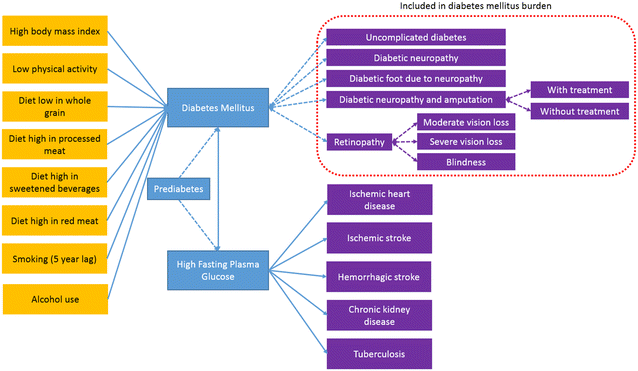
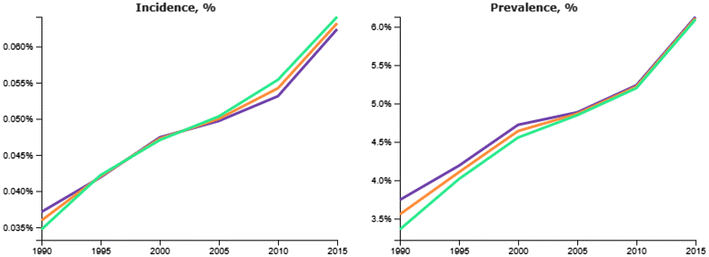
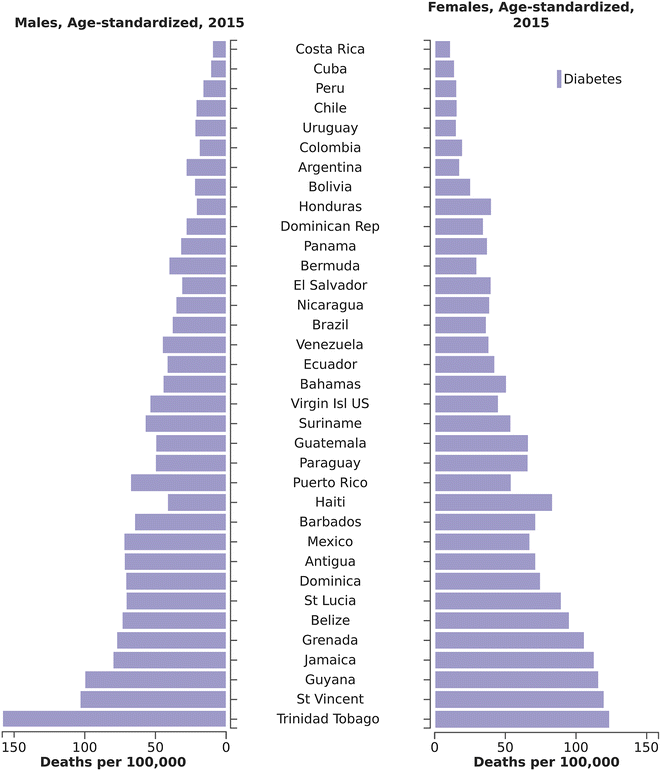
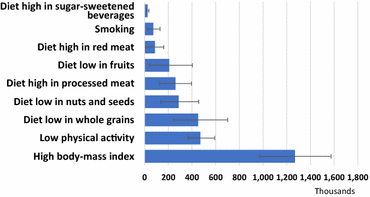
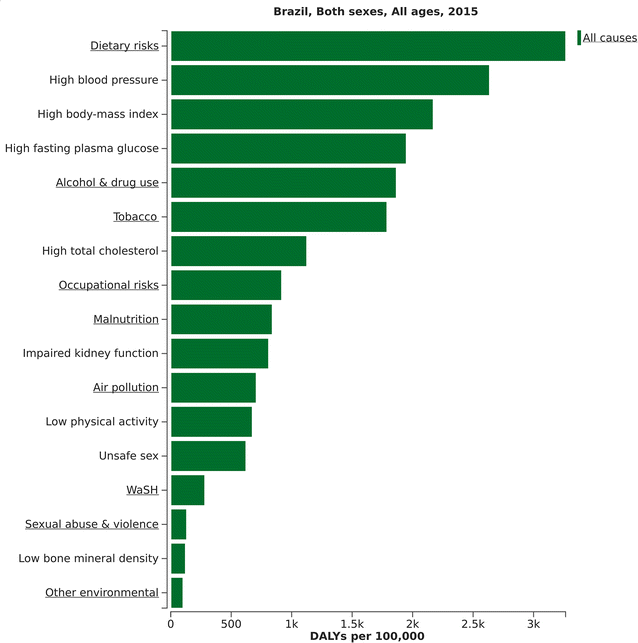

Similar articles
-
The burden of Neglected Tropical Diseases in Brazil, 1990-2016: A subnational analysis from the Global Burden of Disease Study 2016.PLoS Negl Trop Dis. 2018 Jun 4;12(6):e0006559. doi: 10.1371/journal.pntd.0006559. eCollection 2018 Jun. PLoS Negl Trop Dis. 2018. PMID: 29864133 Free PMC article.
-
Burden of chronic kidney disease and its risk-attributable burden in 137 low-and middle-income countries, 1990-2019: results from the global burden of disease study 2019.BMC Nephrol. 2022 Jan 5;23(1):17. doi: 10.1186/s12882-021-02597-3. BMC Nephrol. 2022. PMID: 34986789 Free PMC article.
-
Burden of diabetes, hyperglycaemia in China from to 2016: Findings from the 1990 to 2016, global burden of disease study.Diabetes Metab. 2019 Jun;45(3):286-293. doi: 10.1016/j.diabet.2018.08.008. Epub 2018 Sep 6. Diabetes Metab. 2019. PMID: 30196138
-
Global, regional, and national burden of 12 mental disorders in 204 countries and territories, 1990-2019: a systematic analysis for the Global Burden of Disease Study 2019.Lancet Psychiatry. 2022 Feb;9(2):137-150. doi: 10.1016/S2215-0366(21)00395-3. Epub 2022 Jan 10. Lancet Psychiatry. 2022. PMID: 35026139 Free PMC article.
-
Global burden of disease attributable to mental and substance use disorders: findings from the Global Burden of Disease Study 2010.Lancet. 2013 Nov 9;382(9904):1575-86. doi: 10.1016/S0140-6736(13)61611-6. Epub 2013 Aug 29. Lancet. 2013. PMID: 23993280 Review.
Cited by
-
Direct and Indirect Costs of Diabetes in Brazil in 2016.Ann Glob Health. 2022 Mar 3;88(1):14. doi: 10.5334/aogh.3000. eCollection 2022. Ann Glob Health. 2022. PMID: 35340368 Free PMC article.
-
Physical inactivity as risk factor for mortality by diabetes mellitus in Brazil in 1990, 2006, and 2016.Diabetol Metab Syndr. 2019 Feb 28;11:23. doi: 10.1186/s13098-019-0419-9. eCollection 2019. Diabetol Metab Syndr. 2019. PMID: 30867683 Free PMC article.
-
Diabetes mellitus mortality in a municipality in the state of São Paulo, 2010 to 2014.Rev Saude Publica. 2019 Feb 25;53:24. doi: 10.11606/S1518-8787.2019053000561. Rev Saude Publica. 2019. PMID: 30810661 Free PMC article.
-
The burden of Neglected Tropical Diseases in Brazil, 1990-2016: A subnational analysis from the Global Burden of Disease Study 2016.PLoS Negl Trop Dis. 2018 Jun 4;12(6):e0006559. doi: 10.1371/journal.pntd.0006559. eCollection 2018 Jun. PLoS Negl Trop Dis. 2018. PMID: 29864133 Free PMC article.
-
Lifetime risk of developing diabetes and years of life lost among those with diabetes in Brazil.J Glob Health. 2021 Jul 3;11:04041. doi: 10.7189/jogh.11.04041. eCollection 2021. J Glob Health. 2021. PMID: 34326991 Free PMC article.
References
-
- World Health Organization. Global action plan for the prevention and control of noncommunicable diseases 2013–2020 [Internet]. Geneva: WHO; 2013. http://apps.who.int/iris/bitstream/10665/94384/1/9789241506236_eng.pdf. Accessed 24 June 2016.
-
- United Nations. General Assembly. Outcome document of the high-level meeting of the General Assembly on the comprehensive review and assessment of the progress achieved in the prevention and control of non-communicable diseases [Internet]. New York City: UN; 2014. http://www.who.int/nmh/events/2014/a-res-68-300.pdf. Accessed 24 June 2016.
-
- World Health Organization. Preventing chronic diseases a vital investment [Internet]. Geneva: WHO; 2005. http://www.who.int/chp/chronic_disease_report/full_report.pdf. Accessed 24 June 2016.
-
- Brasil. Ministério da Saúde. Plano de ações estratégicas para o enfrentamento das Doenças Crônicas Não Transmissíveis (DCNT) no Brasil 2011–2022 [Internet]. Brasília: MS; 2011. http://bvsms.saude.gov.br/bvs/publicacoes/plano_acoes_enfrent_dcnt_2011.pdf. Accessed 24 June 2016.
LinkOut - more resources
Full Text Sources
Other Literature Sources
Miscellaneous

